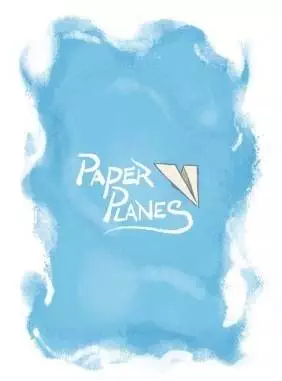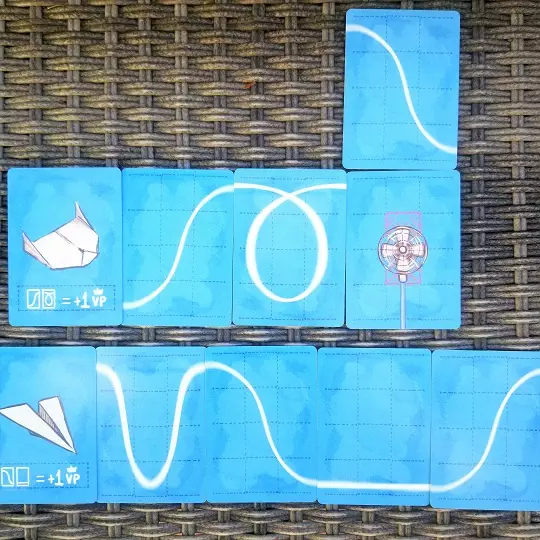
Looping, flapping, long-distance flying, and even boomerang tricks are all possible with a single sheet of paper if you know how to fold it. Designer and artist Eric Streed brings these papercraft airplanes to the tabletop with his newest 18-card microgame: Paper Planes. In Paper Planes, players don’t have to know all of the secrets behind the stunts, but they do need to avoid common obstacles if they hope to have the best flight time – and the most points at the end of the game!
I spent a lot of time as a kid making paper planes with my dad, uncle, and grandfather so Paper Planes brought me a lot of nostalgia. Admittedly, my plane-making skills have gone unused for many years, but this little microgame from Witchway Games has had us testing our abilities all over again. On top of scouring the internet for different plane designs, Ryan and I have been tormenting Morgan with paper planes tossed around the house. It was a bit surprising just how many planes exist on some websites. We recommend looking into it yourself if you are looking for a good bit of fun. The weather here has been atrocious lately, so short, indoor flights have been our only option.
As far as the game goes, Paper Planes is not only easy to play but to teach. Players will choose between either the Classic Dart or Glider for their plane. Both planes offer a different, characterful, way to score extra points at the end of the game. For example, the Glider in this game is more of a stunt plane than the Dart. It awards additional points for including a loop in the flight path after an upward arc. Once planes are chosen, the remaining cards are shuffled and dealt into even piles between both players. To play, each player chooses a card from their hand, placed it face down in front of them, and passes their remaining cards to their opponent. Then, they will simultaneously reveal their chosen card. If the card is an obstacle, the player will place it within their opponent’s flight path. Otherwise, they extend their own. Players with an obstacle in their path will get to use their next turn to try and avoid it. Should a player be unable to avoid an obstacle, their plane crashes. This does not end the game, however. Instead, players continue to pass and draft cards until all cards are taken or both planes have crashed. At the end of the game, points are tallied and the player with the most points is the winner.
We had quite a bit of fun with this one. I really like the fact that having the longest flight path does not ensure a player’s victory. Instead, what a plane does during its flight is much more important than how long it flies. Being so small, Paper Planes is easily portable and can be played almost anywhere, which I truly appreciate as we tend to be on the go quite often. Other than the rules, the game is entirely language-independent and can be taught to almost any age group. We greatly enjoyed playing it one on one with kids and highly recommend it as a gateway game for families. Though not entirely necessary, I would love to see a small expansion with more obstacle cards for added variety. Perhaps with some obstacles that aren’t in the middle column? All in all, Paper Planes was a cute, fun experience for us and one we will be partaking in again. If you’d like your own copy, the game is purchasable from The Game Crafter. There is also a print-and-play version available.
All photos for this article were taken and edited by Krista.
